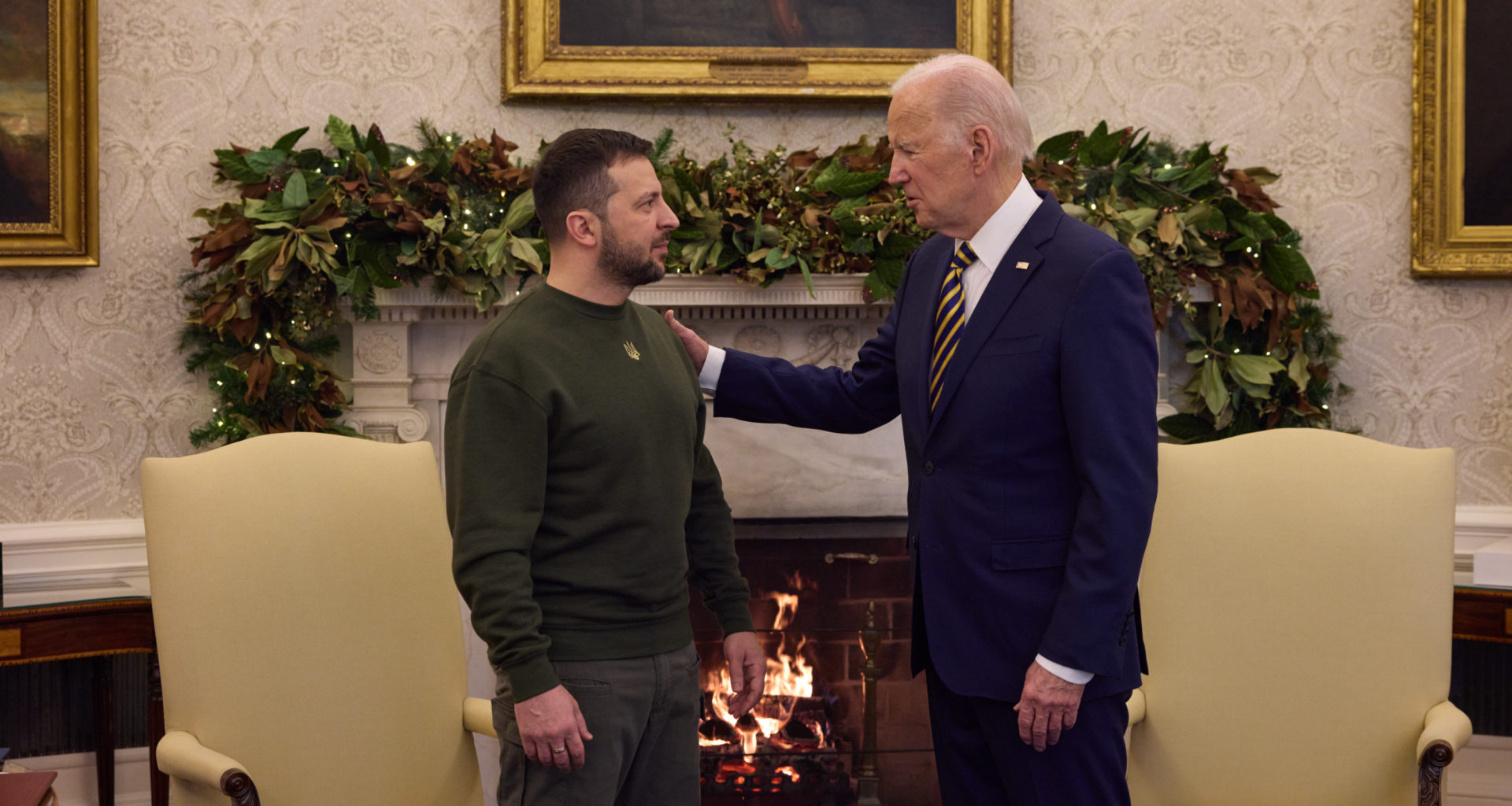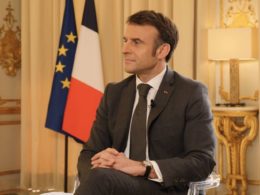On 24 April, President Biden signed into law the national security package that was passed by both the House of Representatives and the Senate. Only hours later, the US announced a significant new security package to meet Ukraine’s critical security and defence needs. After months of delays, obstructions and dithering, the law cleared the way for billions of dollars in fresh Ukraine funding.
President Zelenskyy conveyed his gratitude to the US Senate for approving crucial aid for Ukraine. “This vote reinforces America’s role as a beacon of democracy and leader of the free world,” Zelenskyy said in a statement. “I am grateful to President Biden, the US Congress, and all Americans who realize the need to take the wind out of Putin’s sails.”
What else could he say? He could not possibly have aired his weariness for having been forced to wait in suspense to see if the US would act as a global power or not, all while Ukraine and its defense forces were being destroyed.
The West, not Ukraine, should express its gratitude.
Ukraine is protecting NATO security, paying a high price in blood. The West is providing intelligence, military hardware, and financial and humanitarian support from a safe distance.
Its energy sector has been destroyed. Its armed forces have been reduced. Civilians and soldiers alike have been killed or maimed. Ukraine’s ability to liberate occupied territories has been offset by far more than six months because the support pause allowed Russia to mobilize, set its defense industry on a war footing, build a “coalition of evil,” and grab the battlefield initiative.
For months, Ukraine has been begging for more artillery, air defense systems, long-range missiles, and fighter jets, as the frontline was being pushed westward. The risk of Russia gaining air supremacy, fundamentally changing the nature of the war, grew by the day.
Additionally, Ukraine is suffering from acute and self-inflicted manpower problems. Russian soldiers outnumber Ukrainians by about five to seven times in some sectors because Ukraine delayed the critically important decision to mobilize more personnel for six months.
The delays—both US and Ukrainian—have a tangible psychological impact.
An increasingly defeatist perception has spread across the information space in Europe and the US, inadvertently supporting the Russian false narrative that it cannot be defeated. The Telegraph’s article “Ukraine has only six months left” is the ultimate example of the former, arguing that “the challenges ahead are almost insurmountable.”
In February 2022, several diplomats, analysts, and media outlets believed Ukraine would collapse within days. The notion is again being disseminated, not because of Ukrainian resilience, bravery, or ingenuity but because of the Western lack of these qualities.
A turning point in the war?
The starting point of “what happens next” is degraded compared to October 2023. Ukraine’s ability to launch a new offensive is reduced even compared to last summer. It has lost both manpower and equipment while waiting for the US to act according to the Truman Doctrine and Washington Treaty:
- provide political, military, and economic assistance to all democratic nations under threat from external or internal authoritarian forces, and
- protect Europe.
The US only resumed support it stopped six months ago. Its defense aid is still symbolic. It helps Ukraine continue fighting but not winning:
- Instead of providing HIMARS and Abrams in the hundreds, it is providing them in two-digit numbers.
- It is not providing Air Power (F-16).
- It has until now, denied Ukraine long-range strike capacity.
- It is, however, still denying Ukraine the opportunity to strike legal targets on Russian territory.
- It is still not providing Air Defence in sufficient numbers to stop Russian missiles and drones launched from its territory.
The US support does not mark a huge step forward. It marks a step away from the abyss.
Russia maintains a manpower and weapons advantage. It has the battlefield initiative. It has established well-prepared and fortified defensive positions.
Still, Democratic Majority Leader Chuck Schumer told President Zelenskyy on Tuesday night, “Ok, we got it done. Now go win the fight.”
A war-winning strategy?
The US has lacked a clear war-winning strategy throughout.
According to the bill passed by the House of Representatives, however, “the Secretary of State and the Secretary of Defence, in consultation with the heads of other relevant Federal agencies, as appropriate, shall submit to the Committees on Appropriations, Armed Services, and Foreign Relations of the Senate and the Committees on Appropriations, Armed Services, and Foreign Affairs of the House of Representatives a strategy regarding United States support for Ukraine against aggression by the Russian Federation” no later than 45 days after the date of enactment of the act.
The strategy must establish specific and achievable objectives, define and prioritize United States national security interests, and include the metrics to be used to measure progress in achieving such objectives.
The strategy shall include an estimate of “the resources required by the United States to achieve such objectives, including to help hasten Ukrainian victory against Russia’s invasion forces in a manner most favorable to United States interests and objectives, and a description of the national security implications for the United States if those objectives are not met.”
While the term “Ukrainian victory” is encouraging, it might also be deceiving. According to Alyona Getmanchuk, “It is important to distinguish clearly among the American political elite between:
- the voices of those who genuinely support Ukraine’s victory and Russia’s defeat and those who use the demand for the US president to develop a strategy for Ukrainian victory as a kind of political trap, on the understanding that the latter will not do so;
- the voices of those who use the word “victory” in the way Ukrainians do and those who try to package the word as the act of preserving Ukraine’s statehood, albeit with 20% or even more of its territories occupied by the Russian Federation.
The second position is not even concealed. There have been numerous public statements by the current administration that “Russia has strategically lost, Ukraine has strategically won.” Thus, these statements twist the facts, equating Ukraine’s victory with its survival, saying: “you have survived, so this is your victory.”
According to US Assistant Secretary of State for European and Eurasian Affairs James O’Brien, the Biden administration’s initial response lists three elements:
- Ukraine’s continued fight for its survival,
- The beginning of accession negotiations with the EU, and
- Then, putting in place a sort of path forward to membership in NATO (after the end of the war and implementation of reforms).
While the strategy has not yet been made public, it is more likely to be based on past strategic considerations than outline a new and war-winning strategy. This will be reflected in the US actions: the quantity of weapon systems it donates (or not) to Ukraine.
Additionally, the presidential election makes any suggestions of military intervention nearly impossible. About 70% of Americans want the US to push Ukraine toward a negotiated peace with Russia, according to a recent survey. Only about 5% support US “boots on the ground”.
The US will not help close the sky over Ukraine to protect cities or support the Ukrainian men and women holding the frontline, defending Europe. Neither the US nor Europe is about to explore the window of opportunity created by Ukraine in the Black Sea and deploy a maritime task force. They are not about to shift the military balance on the battlefield but more likely, uphold its “no boots on the ground” policy.
The US – and therefore, Europe, will in all likelihood continue pursuing the very same strategy that allowed peace to turn into war, and an attempted “Blitz Krieg” into a protracted war undermining both Ukraine and Europe.
After six months of US absence, the National Security Council spokesperson John Kirby on 23 April hinted that “Ukraine still doesn’t have a fully formed plan to defeat Russia”. He failed to mention that planning is impossible as Ukraine does not know if, what, when, and how much the US and Europe will provide ammunition and weapons. This is less so since its partners are not setting up Ukraine for victory.
US leadership
“It was a difficult path. It should have been easier, and it should have gotten there sooner. But in the end, we did what America always does: We rose to the moment, we came together, and we got it done. Now we need to move fast, and we are,” President Biden said in a statement on the Passage of H.R. 815, the National Security Supplemental.
A six-month decision process during a fundamental war in the heart of Europe – a war that is, first of all, a confrontation between Russia and the West while Russian hybrid aggressions are taking place across the Alliance – cannot be described as leadership.
It has raised concerns in Europe about whether the US will live up to its NATO commitment. The world—including autocracies considering following Russia’s example—is questioning the US Pacific commitments because it is failing to protect its European allies, including its failure to act in the spirit of the Budapest Memorandum.
Equally crucial, Russia, Ukraine, and the US closest allies are asking themselves what the process will be like next year. If the US failed to understand the need to provide military and economic assistance to a democratic nation under threat from an external authoritarian force in 2023 – and why defeating Russia in Ukraine is in the US national interest – why should anyone expect the post-election aid process to be smoother?
The US Congress is not about to get smarter
In the words of George F. Will, columnist at The Washington Post: “A majority of House Republicans voted last Saturday to endanger civilization. Hoping to enhance their political security in their mostly safe seats, and for the infantile satisfaction of populist naughtiness (insulting a mostly fictitious “establishment”), they voted to assure Vladimir Putin’s attempt to erase a European nation.”
Congress is still giving Russian propaganda a voice. The House passed the Ukraine funding by 311-112, with all “nays” coming from Republicans, many of whom were bitterly opposed to further assistance for Kyiv. Some of their arguments against further support for Ukraine and, consequently, Europe are based on Russian disinformation.
According to House Intelligence Committee chair Mike Turner (R-Ohio), “It is absolutely true we see, directly coming from Russia, attempts to mask communications that are anti-Ukraine and pro-Russia messages, some of which we even hear being uttered on the House floor.” In his testimony to the United States House Committee on Oversight and Accountability, Professor Timothy Snyder listed a number of Russian memes created to undermine both the US and Ukraine, used by members of the Republican Party.
Russian disinformation has shaped the views and rhetoric of Republican elected officials, most of whom are closely linked to former President Trump.
While the bill passed with a great majority after half a year of delays and hesitations, the process demonstrated a dysfunctional system that allowed a minority to temporarily cancel democracy at the peril of the democratic world.
Mistakes to be avoided
Having been brought back from the verge of collapse, we must not misinterpret the feeling of relief with strategic change. Supporting Ukraine – and, therefore, supporting European security – is a question of strategic awareness, commitment, and credibility.
The costs of failing would be devastating, but the US might still be on the verge of doing just that.
The worst-case scenario – a Ukrainian defeat – is still a possible outcome. The lack of Ukrainian soldiers will remain a critical vulnerability in the months to come. Russia is still mobilizing more soldiers than it is losing on the battlefield. It is not facing the logistical shortcomings or diplomatic limitations that Ukraine suffers. Russia continues to strengthen its cooperation with China, Iran, and North Korea. The axis is still spreading regional conflicts, spreading the West’s attention span and force structure accordingly.
More importantly, the US (indirect] return to the battlefield does not change the military balance. Having lost the battle in the cognitive space, US and European direct military involvement – or a Ukrainian NATO membership this year – remains, unfortunately, highly unlikely.
Still, we run the risk of politicians and media alike turning relief and enthusiasm into yet more unrealistic expectations.
It is important to understand that Ukraine will not be better positioned to conduct a counteroffensive this year than last summer. It still lacks critical capabilities.
More importantly, Russia is stronger than last year. It has mobilized more soldiers, put the defense industry on a war footing, and established an increasingly more coordinated coalition (China, Iran, and North Korea). Slow and incremental Western defense support – and six months of husbanding of ammunition as the US stopped supporting Ukraine’s war efforts – has allowed Russia to take and maintain the initiative on the battlefield.
The US six-month decision process has not changed the trajectory of the war. It will remain protracted until the West decides to ensure a Ukrainian victory. The US defense ad will probably only help stabilize the frontline for this year, enabling Ukraine to begin preparations for offensive operations in 2025 IF – and it is a big IF – if the US can provide another security package for next year.








